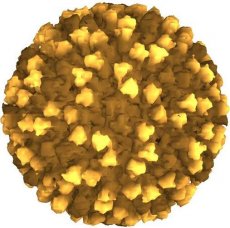Medical expert of the article
New publications
Reoviruses, genus orbiviruses
Last reviewed: 04.07.2025

All iLive content is medically reviewed or fact checked to ensure as much factual accuracy as possible.
We have strict sourcing guidelines and only link to reputable media sites, academic research institutions and, whenever possible, medically peer reviewed studies. Note that the numbers in parentheses ([1], [2], etc.) are clickable links to these studies.
If you feel that any of our content is inaccurate, out-of-date, or otherwise questionable, please select it and press Ctrl + Enter.

Characteristics of the virus
Representatives of orbiviruses - Colorado tick fever viruses, Kemerovo group viruses, etc. - are typical arboviruses transmitted by Aedes mosquitoes, biting midges and ticks. These viruses are mainly of veterinary importance, but some of them can cause mild febrile diseases in humans. Orbiviruses are spherical, the virion diameter is 60-80 nm. The genome is represented by double-stranded RNA, consisting of 10 fragments and having a molecular weight of 12 MD. There is virion transcriptase. The capsid is two-layered, 32 ring-shaped capsomeres (Latin orbis - ring) are packed into an icosahedron. A fluffy protein layer, difficult to see even with electron microscopy, covers the main capsid from the outside. There is no supercapsid. The replicative cycle is similar to the reovirus cycle. Orbiviruses are sensitive to low pH values, inactivated at pH less than 3.0.
 [ 5 ], [ 6 ], [ 7 ], [ 8 ], [ 9 ], [ 10 ], [ 11 ]
[ 5 ], [ 6 ], [ 7 ], [ 8 ], [ 9 ], [ 10 ], [ 11 ]
Colorado tick fever
The disease is registered on the Pacific coast of the USA, mainly in mountainous rural areas. The virus is transmitted through the bites of the infected tick Dermacentor andersoni and circulates in the blood in the acute stage of the disease. The incubation period is 4-6 days. The onset is acute - chills, myalgia, headache, nausea, vomiting. The fever has a two-wave character, leukopenia is observed. The outcome is favorable. Immunity after the disease is humoral, long-lasting.
Laboratory diagnostics
During the first 14 days of the disease, the virus is isolated from the blood by intracerebral or intraperitoneal infection of young hamsters or newborn mice. Complement-fixing and virus-neutralizing antibodies appear on the 2nd week of the disease and persist for up to 3 years.

